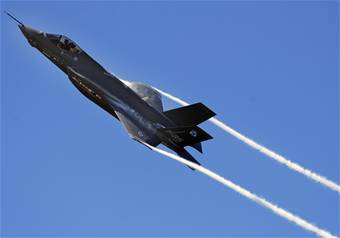The F-35 Joint Strike Fighter Sensors have participated in the Northern Edge 2011 for the second time, and have been tested in the multi-operational environment in Alaska from June 13 to 24, 2011.
The Northern Edge, hosted by Alaskan Command, is a biennial U.S. Pacific Command exercise, which prepares joint forces to react to crisis across the Asia-Pacific region. The performance of the F-35 JSF systems in numerous electronic warfare scenarios was an invaluable opportunity.
 F-35 Joint Strike Fighter
F-35 Joint Strike Fighter
The AN/AAQ-37 Distributed Aperture System (DAS) and the AN/APG-81 active electronically scanned array radar (AESA) were installed on board Northrop Grumman’s BAC 1-11 test aircraft. The AN/AAQ-37 DAS, which was designed mainly to track multiple aircrafts simultaneously in all directions, made its debut, demonstrating its spherical situational awareness in an air combat environment. The AN/APG-81 AESA, which is participating again in the Northern Edge exercise, has exhibited its robust electronic protection, passive maritime, electronic attack, data-linked air, experimental nodes and surface tracks, which would all lead to an improved legacy fighter situational awareness. The AESA also investigated the whole operating area of Gulf of Alaska, searching for surface vessels and precisely detecting and tracking them in a negligible amount of time.
Erik Etz, who is the Navy Commander of the Deputy Missions Systems Integrated Product Team at the F-35 JSF Program Office, revealed that both sensors had been rigorously tested during Northern Edge 2011 and this would prove to be a momentous risk reduction step for the F-35 JSF program. According to him, they had demonstrated key war fighting capabilities, much ahead of the scheduled operational testing by positioning these systems in a rigorous environment.
System operators had to face the seasonal weather challenges as this exercise was conducted in the month of June with its cloudy and inclement weather, which hindered in-flight visibility. The DAS provided discernable and clear horizons along with views of nearby aircraft and views of ground features. Night vision functions could not be tested as it was not dark enough. Further, a surrogate test visor was utilized to display DAS imagery for the operators.
Peter Bartos, Test Director at Northrop Grumman, stated that these sensor systems provided immense possibilities of usage for the F-35 JSF sensors in the air-land-sea battle. This testing had confirmed the operational utility and maturity of the systems and has also been useful for identifying areas, where refinement is necessary, even before formal operational testing could be carried out on the F-35 JSF airframe. According to him, this would eliminate the guess work out of testing and development and also minimize or totally avoid issues that have normally beleaguered several other major development programs.
Source:
Northern Edge Joint Information Bureau